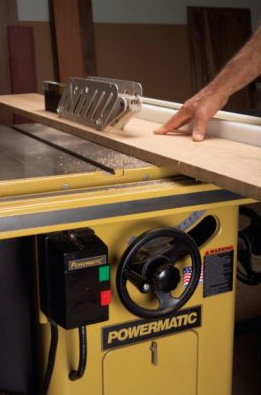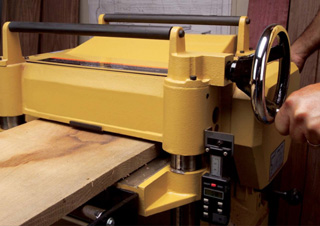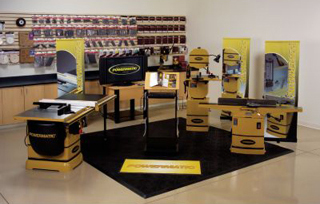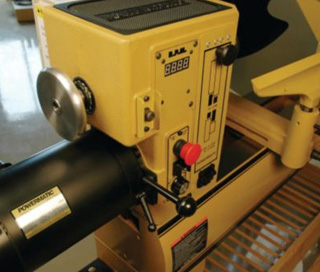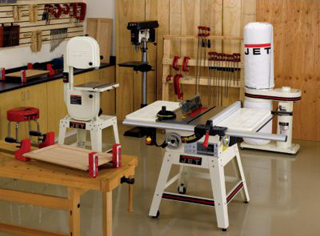
Over the past couple of years, only a hermit would have been able to be able to miss this recession’s effects. From the automotive industry to banking to housing — and probably every profit-making sector in between — organizations are feeling the shock waves and trying to do more with less. The power tool industry, of course, isn’t exempt from this situation. Now, the challenge remains: how to move forward building quality woodworking products at prices we can still afford.
Barry Schwaiger, JET and Powermatic’s internal manager of the woodworking division, recently filled me in on how these brands have been affected by the downturn. He also wanted to share some steps the company is taking to ensure solid product offerings now and for the future.
Not surprisingly, the company has had to tighten its belt. Costs in a number of areas were trimmed proportionate to the sales declines it has experienced over the past couple years. Those were tough measures to take, Schwaiger says, with some unfortunate ramifications. “This has been one of the most difficult periods for our company as we reflect on this particular recession compared to prior economic downturns…We had to make some staff reductions and shut down one of our distribution centers that we’ve had for many years. That was a very emotional decision for us. Some long-term employees were displaced because of it, and that’s painful for a company that truly operates like a family business.”
Despite these cutbacks, Schwaiger maintains that JET/Powermatic has never wavered on its core commitment to customer value. There have been no changes made to current, continuing products in order to shave manufacturing or material costs. Metal gauges in steel cabinets, for instance, remain the same. Castings are as thick as ever. All solid tool features that woodworkers have come to expect remain in place. Warranties are strong.
Still, in the process of reviewing the overall product family between the two brands, certain offerings on the accessory side of the business will be discontinued. For example, plans are in place to reduce or eliminate dust collection piping components, molding knives, turning chisels and face plates, and sanding abrasives, to name a few. Barry says the company realized that, to some extent, it cannot continue to be all things to all people as a generalized OEM provider.
“If there’s a product we’re selling whereby we aren’t bringing real value to the end user, we’ve elected to get out of that business…We’d rather put you in touch directly with our supplier of, say, molding knives, so you can get what you need promptly and straight away from them,” Schwaiger contends. “We’re getting out of the way of that process.”
The company’s “value proposition” to customers goes beyond nuts and bolts to customer service after the sale. This, too, remains unchanged. Schwaiger says that the barriers for entry into the stationary power tool market are actually very low, and basically “anyone with a small investment can run to Asia with a can of paint and become an importer of stationary power tools.” While those machines might seem like great buys on the showroom floor, the value may not extend much further than that with brands that lack the infrastructure to support good service.
“Will there be someone on the other end of the phone years later to send you a service part? We look at our customers has having made an investment in our company as well as our products. Your investment includes an experienced tech service person in the U.S. to talk to when you need them, a five million dollar inventory of service parts, an entire organization at our factories that inspects 100 percent of our machines prior to packaging, a warranty and service center organization that is unmatched, as well as a whole host of support and service that you would expect from a well-established brand. That being said, we spend a tremendous amount of time to ensure that the additional amount you pay for our machines, over alternatives, represents an excellent investment.”
Barry added that, at some point or another, many brands may try to enhance a current tool’s design by inventing features which solve problems that don’t really exist. He cited several examples, such as lasers on jigsaws, cordless routers or exaggerated knobs in a different color, asking, are we really getting products that improve what we do in our shops? Instead, Barry says JET and Powermatic remain committed to innovation that is grounded in real-world feedback. “We work with some of the most experienced woodworkers in the industry and make sure that our ideas pass many wisdom tests prior to implementing. Our thoughts are, if you can satisfy the most discriminating critics…then you are less likely to implement features or benefits that aren’t worth the marginal costs.”
So, what’s in store from JET and Powermatic as we move into 2011? Barry provided a few sneak peeks worth keeping in mind if you’re planning to purchase a machine next year. On the JET side, we can look forward to some exciting new dust collection technology coming to market in the first quarter. JET will also provide updated riving knife systems on all table saws that don’t currently have them.
Powermatic will be celebrating its 90th anniversary as well. The brand will be revisiting the wood lathe category, and the company is considering a new warranty program that’s unique to the anniversary year.
Are brighter days to come for these long-standing brands? Schwaiger says yes. “In the aftermath of this downturn, we have emerged as a stronger, healthier company than we were before…We’re on the cusp of a major product initiative that will step out over the next three to five years…Now we’re poised for investment in our future.”
